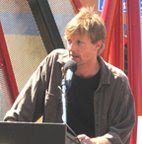It seems that the term "scenic artist" still presents some confusion to people unfamiliar with the term who are new to my work, so I'm writing a quick clarificiation today.
Many people associate the word "scenic" with the word "landscape", and assume that as a scenic artist, I am primarily or exclusively a landscape painter. While much of my mural work and some of my fine art paintings involve landscapes of one kind or another, and while I enjoy painting landscapes and the landscape components of my differnet projects, this is only one facet of the scenic artist's trade.
Most simply put, a scenic artist works on sets, that is, the scenery created for live theater, dance, television and film production, theme park exhibits and rides, casinos, industrial and trade shows, retail outlets, restaurants and any other situation where walls, foors, ceilings, and furnishings serve, in addition to their obvious functions, an entertainment purpose. (Designers and artisans specializing in this work are often now collectively referred to as the the "themed entertainment" business.)
Specifically, scenic artists typically create the final finishes on surfaces and objects created by other artisans. For instance, a scenic would paint the Tuscan mural in an Italian restarant over a wall prepared by carpenters and plasterers, or a distressed/antique paint job on the restaurant's tables and chairs.
A good scenic artist can make drywall look like wood, plywood look like metal, a new table look old, a flat wall look three dimensional, bring the outdoors inside, make a jungle out of a stucco wall, etc. Also, a good scenic works in three dimensions as well, creating textures, reliefs, sculptures or whatever is required to achieve the intended effect.
In addition to drawing and painting, I am well versed in finish carpentry, furniture contruction, wood turning, basic welding and metal fabrication, gilding, moldmaking and casting using plaster, fiber glass and other composite materials.
A good scenic is also part designer, because our job is usually to realize other people's ideas, and often times to create a new way of building or finishing something to make those ideas "come true". In this light, I think it is extremely important for a good scenic to be well versed in art history, the history of architecture, contemporary design and bulding practices, and especially these days, green and environmentally friendly technologies and alternatives to the methods of the past.
While somewhat complicated, I hope this post simplifies the differences between a "scenic artist" and landscape painter, faux finish artist, muralist, painting contractor and many of the other terms commonly used to describe our work, and also why I proudly continue to describe myself as a scenic artist even though the majority of my work these days falls somewhat outside the themed entertainment community.
FlySFO
-
As a contract front end developer, I enhanced several features on the way
to the release of the new San Francisco International Airport site.
5 years ago






